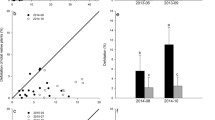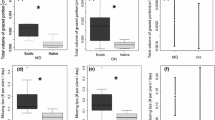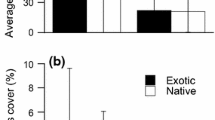Abstract
Studies of herbivory and its consequences on the growth of native and exotic plants could help elucidate some processes involved in plant invasions. Introduced species are likely to experience reduced herbivory in their new range due to the absence of specialist enemies and, thus, may have higher benefits if they reduce the investment in resistance and increase their compensatory capacity. In order to evaluate the role of herbivory in disturbed areas within the Patagonian steppe, we quantified and compared the leaf levels of herbivory of four native and five exotic species and recorded the associated insect fauna. We also performed greenhouse experiments in which we simulated herbivory in order to evaluate the compensatory capacity of native and exotic species under different herbivory levels that resembled naturally occurring damage. Natural herbivory levels in the field were similar between the studied exotic and native plants. Field observations confirmed that they both shared some herbivore insects, most of which are generalists. In the greenhouse experiments, both exotic and native plants fully compensated for herbivory. Our results suggest that the studied exotic plants are not released from herbivory in the Patagonian steppe but are able to fully compensate for it. The capacity to recover from herbivory coupled with other potential adaptations, such as a better performance under disturbance and greater competitive ability than that of the native species, may represent some of the mechanisms responsible for the success of plant invasion in the Patagonian steppe.



Similar content being viewed by others
References
Agrawal AA, Kotanen PM (2003) Herbivores and success of exotic plants: a phylogenetically controlled experiment. Ecol Lett 6:712–715
Agrawal AA, Kotanen PM, Mitchell CE, Power AG, Godsoe W, Klironomos J (2005) Enemy release? An experiment with congeneric plant pairs and diverse above and belowground enemies. Ecology 86:2979–2989
Aguiar MR, Sala OE (1998) Interactions among grasses, shrubs and herbivores in Patagonian grass-shrub steppe. Ecol Austral 8:201–210
Aizen M, Vazquez D, Smith-Ramirez C (2002) Historia natural y conservación de mutualismos planta-animal del bosque templado de Sudamérica austral. Rev Chil Hist Nat 75:79–97
Blossey B, Nötzold R (1995) Evolution of increased competitive ability in invasive non-indigenous plants: a hypothesis. J Ecol 83:887–889
Briske DD, Boutton TW, Wang Z (1996) Contribution of flexible allocation priorities to herbivory tolerance in C-4 perennial grasses: an evaluation with 13C labeling. Oecologia 105:151–159
Bushman BS, Scholte AA, Cornish K, Scott DJ, Brichta JL, Vederas JC, Ochoa O, Michelmore RW, Shintani DK, Knapp SJ (2006) Identification and comparison of natural rubber from two Lactuca species. Phytochemistry 67:2590–2596
Carpenter D, Cappuccino N (2005) Herbivory, time since introduction and the invasiveness of exotic plants. J Ecol 93:315–321
Cincotta C, Adams JM, Holzapfel C (2009) Testing the enemy release hypothesis: a comparison of foliar insect herbivory of the exotic Norway maple (Acer platanoides L.) and the native sugar maple (A. saccharum L.). Biol Invasions 11:379–388
Colautti RI, Ricciardi A, Grigorovich IA, Maclsaac HJ (2004) Is invasion success explained by the enemy release hypothesis? Ecol Lett 7:721–733
Coley PD (1980) Effects of leaf age and plant life history patterns on herbivory. Nature 284:545–546
Correa MN (1969–1998) Flora Patagónica, vol 7. Instituto Nacional de Tecnología Agropecuaria, Buenos Aires
D’Antonio CM, Mahall BE (1991) Root profiles and competition between the invasive, exotic perennial, Carpobrotus edulis, and two native shrub species in California coastal scrub. Am J Bot 78:885–894
de la Fuente M-A, Dyer LA, Bowers MD (1994) The iridoid glycoside, catalpol, as a deterrent to the predator Camponotus fioridanus (Formicidae). Chemoecology 5:13–18
Elton CS (1958) The ecology of invasions by animals and plants. Methuen, London
Ezcurra C, Brion C (2005) Plantas del Nahuel Huapi, catálogo de la Flora Vascular del Parque Nacional Nahuel Huapi. Universidad Nacional del Comahue, Bariloche
Farji-Brener AG (1996) Posibles vías de expansión de la hormiga cortadora de hojas Acromyrmex lobicornis hacia la Patagonia. Ecol Austral 6:144–150
Farji-Brener AG (2000) Leaf-cutting ant nests in temperate environments: mounds, mound damages and nest mortality rate in Acromyrmex lobicornis. Stud Neotrop Fauna Environ 35:131–138
Farji-Brener AG (2007) How plants may benefit from their consumers: leaf cutting ants indirectly improve anti-herbivore defenses in Carduus nutans L. Plant Ecol 193:31–38
Farji-Brener AG, Ghermandi L (2000) The influence of nests of leaf-cutting ants on plant species diversity in road verges of northern Patagonia. J Veg Sci 11:453–460
Farji-Brener AG, Ghermandi L (2004) Seedling recruitment in a semi-arid Patagonian steppe: facilitative effects of refuse dumps of leaf-cutting ants. J Veg Sci 15:823–830
Farji-Brener AG, Ghermandi L (2008) Leaf-cutting ant nests near roads increase fitness of exotic plant species in natural protected areas. Proc R Soc Lond Ser B Biol Sci 275:1431–1440
Farji-Brener AG, Gianoli E, Molina-Montenegro M (2009) Small-scale disturbances spread along trophic chains: leaf-cutting ant nests, plants, aphids, and tending ants. Ecol Res 24:139–145
Farji-Brener AG, Lescano N, Ghermandi L (2010) Ecological engineering by a native leaf-cutting ant increases the performance of exotic plant species. Oecologia 163:163–169
Franzel C, Farji-Brener AG (2000) Oportunistas o selectivas? Plasticidad en la dieta de la hormiga cortadora de hojas Acromymex lobicornis en el noroeste de la Patagonia. Ecol Austral 10:159–168
García-Robledo C (2005) Comparación de dos métodos para medir herbivoría ¿Es la herbivoría en el Neotrópico mayor de lo que creemos? Rev Biol Trop 53:111–114
Golluscio RA, Cavagnaro FP, Valenta MD (2011) Arbustos de la estepa patagónica: ¿adaptados a tolerar la sequía o el pastoreo? Ecol Austral 21:61–70
Hamilton JG, Holzapfel C, Mahall B (1999) Coexistence and interference between a native perennial grass and non-native annual grasses in California. Oecologia 121:518–526
Horvitz C, Schemske D (2002) Effects of plant size, leaf herbivory, local competition and fruit production on survival, growth and future reproduction of a neotropical herb. J Ecol 90:279–290
Houle G, Simard G (1996) Additive effects of genotype, nutrient availability and type of tissue damage on the compensatory response of Salix planifolia ssp. planifolia to stimulated herbivory. Oecologia 107:373–378
Jongejans E, Sheppard AW, Shea K (2006) What controls the population dynamics of the invasive thistle Carduus nutans in its native range? J Appl Ecol 43:877–886
Jordon-Thaden IM, Louda SM (2003) Chemistry of Cirsium and Carduus: a role in ecological risk assessment for biological control of weeds? Biochem Syst Ecol 31:1353–1396
Keane RM, Crawley MJ (2002) Exotic plant invasions and the enemy release hypothesis. Trends Ecol Evol 17:164–170
Lescano MN, Farji-Brener A (2010) Exotic thistles increase native ant abundance through the maintenance of enhanced aphid populations. Ecol Res 26:827–834
Levine JM, Adler PB, Yelenik SG (2004) A meta-analysis of biotic resistance to exotic plant invasions. Ecol Lett 7:975–989
Liu H, Stiling P (2006) Testing the enemy release hypothesis: a review and meta-analysis. Biol Invasions 8:1535–1545
Mabry CM, Wayne PW (1997) Defoliation of the annual herb Abutilon theophrasti: mechanisms underlying reproductive compensation. Oecologia 111:225–232
Mack RN, Simberloff D, Lonsdale WM, Evans H, Clout M, Bazzaz FA (2000) Biotic invasions: causes, epidemiology, global consequences, and control. Ecol Appl 10:689–710
Margutti L, Ghermandi L, Rapoport E (1996) Seed bank and vegetation in a Patagonian roadside. Int J Ecol Environ Sci 22:159–175
Memmott J, Fowler SV, Paynter Q, Sheppard AW, Syrett P (2000) The invertebrate fauna on broom, Cytisus scoparius, in two native and two exotic habitats. Acta Oecol 21:213–222
Parker JD, Hay ME (2005) Biotic resistance to plant invasions? Native herbivores prefer non-native plants. Ecol Lett 8:959–967
Radho-Toly S, Majer JD, Yates C (2001) Impact of fire on leaf nutrients, arthropod fauna and herbivory of native and exotic eucalypts in Kings Park, Perth, Western Australia. Austral Ecol 26:500–506
Ramos MV, Grangeiro TB, Freire ED, Sales MP, Souza DP, Araújo ES, Freitas CDT (2010) The defensive role of latex in plants: detrimental effects on insects. Arthropod Plant Interact 4:57–67
Rapoport EH (1991) Tropical versus temperate weeds: a glance into the present and future. In: Ramakrishnan P (ed) Ecology of biological invasion in the tropics. ISF, New Delhi, pp 11–51
Rapoport EH (1993) The process of plant colonization in small settlements and large cities. In: McDonnell M, Pickett S (eds) Humans as components of ecosystems. Springer, New York, pp 178–196
Ridenour WM, Callaway RM (2001) The relative importance of allelopathy in interference: the effects of an invasive weed on a native bunchgrass. Oecologia 126:444–450
Rogers WE, Siemann E (2004) Invasive ecotypes tolerate herbivory more effectively than native ecotypes of the Chinese tallow tree Sapium sebiferum. J Appl Ecol 41:561–570
Rosenthal JP, Kotanen PM (1994) Terrestrial plant tolerance to herbivory. Trends Ecol Evol 9:145–148
Rosenthal JP, Welter SC (1995) Tolerance to herbivory by a stemboring caterpillar in architecturally distinct maizes and wild relatives. Oecologia 102:146–155
Schierenbeck KA, Mack RN, Sharitz RR (1994) Effects of herbivory on growth and biomass allocation in native and introduced species of Lonicera. Ecology 75:1661–1672
Schmeda-Hirshmann G, Jordan M, Gerth A, Wilken D (2005) Secondary metabolite content in rhizomes, callus cultures and in vitro regenerated plantlets of Solidago chilensis. Z Naturforsch C 60:5–10
Speziale KL, Ezcurra C (2011) Patterns of alien plant invasions in northwestern Patagonia, Argentina. J Arid Environ 75:890–897
Stastny M, Schaffner U, Elle E (2005) Do vigour of introduced populations and escape from specialist herbivores contribute to invasiveness? J Ecol 93:27–37
Stowe KA, Marquis RJ, Hochwender CG, Simms EL (2000) The evolutionary ecology of tolerance to consumer damage. Annu Rev Ecol Syst 31:565–595
Strauss SY, Agrawal AA (1999) The ecology and evolution of plant tolerance to herbivory. Trends Ecol Evol 14:179–185
Woodman RL, Fernandes GW (1991) Differential mechanical defense: herbivory, evapotranspiration, and leaf-hairs. Oikos 60:11–19
Zou J, Rogers WE, Siemann E (2008) Increased competitive ability and herbivory tolerance in the invasive plant Sapium sebiferum. Biol Invasions 10:291–302
Zuloaga FO, Morrone O, Belgrano MJ (2008) Catálogo de las plantas vasculares del Cono Sur (Argentina, Sur de Brasil, Chile, Paraguay y Uruguay). Missouri Botanical Garden Press
Zunino MP, Novillo-Newton M, Maestri DM, Zygadlo JA (1997) Composition of the essential oil of Baccharis crispa Spreng. and Baccharis salicifolia Pers. grown in Cordoba (Argentina). Flavour Fragr J 12:405–407
Acknowledgments
We thank M. Nuñez and two anonymous reviewers for their useful suggestions that helped to improve this paper. We acknowledge N. Lescano, S. González, J. Franzese, C. Ezcurra, L. Ghermandi, Y. Sasal, L. Elizalde and C. Ziperovich for their assistance at several stages of this study. We also acknowledge Kristi and Kadri Laar for reading and improving the manuscript. G.P. was supported by a Postdoctoral fellowship from CONICET (Consejo Nacional de Investigaciones Científicas y Técnicas) and financial support was partially supplied by ANPCyT of Argentina (recently through PICT 2008-0352).
Author information
Authors and Affiliations
Corresponding author
About this article
Cite this article
Pirk, G.I., Farji-Brener, A.G. Foliar herbivory and its effects on plant growth in native and exotic species in the Patagonian steppe. Ecol Res 27, 903–912 (2012). https://doi.org/10.1007/s11284-012-0968-y
Received:
Accepted:
Published:
Issue Date:
DOI: https://doi.org/10.1007/s11284-012-0968-y




